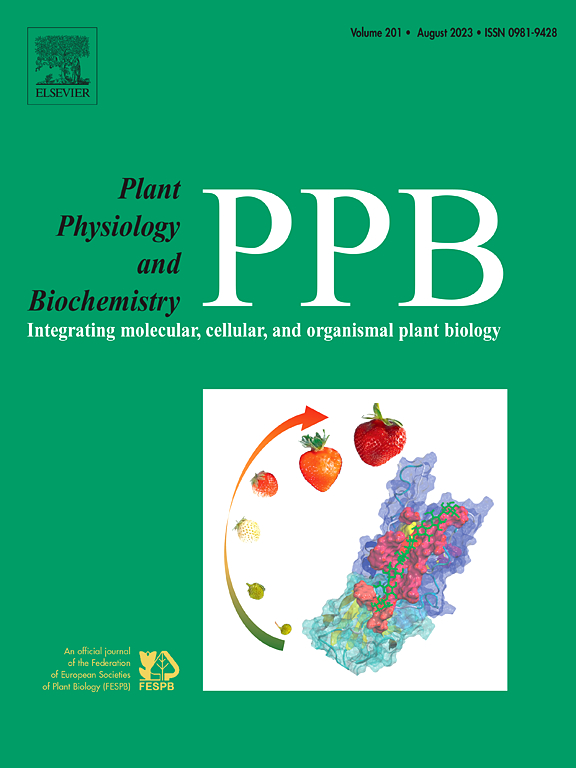Physiological mechanisms of heavy metal detoxification in tomato plants mediated by endophytic fungi under nickel and cadmium stress
IF 6.1
2区 生物学
Q1 PLANT SCIENCES
引用次数: 0
Abstract
Heavy metal (HM) pollution in agricultural soils threatens plant growth and food security, underscoring the urgency for sustainable and eco-friendly solutions. This study investigates the potential of endophytic fungi, Fusarium proliferatum SL3 and Aspergillus terreus MGRF2, in mitigating nickel (Ni) and cadmium (Cd) stress in Solanum lycopersicum (tomato). These fungi were evaluated for their plant growth-promoting traits, including the production of indole-3-acetic acid (IAA) and siderophores, offering a sustainable strategy for alleviating HM toxicity. Inoculation with SL3 and MGRF2 significantly reduced metal accumulation in plant tissues by enhancing metal immobilization and modifying root architecture. Microscopic analysis revealed that fungi protected root epidermal cells from Ni- and Cd-induced damage, preserving cellular integrity and preventing plasmolysis. Fungal-treated plants exhibited improved growth and biomass, with SL3 demonstrating superior Cd stress mitigation and MGRF2 excelling under Ni stress. Photosynthetic pigment levels, including chlorophyll-a and carotenoids, were restored, highlighting the role of fungi in maintaining photosynthetic efficiency. Antioxidant activity was also modulated, as reduced glutathione (GSH) levels and increased flavonoid production were observed, contributing to enhanced oxidative stress management. Hormonal profiling revealed that fungal inoculation balanced stress-induced hormonal disruptions, with lower abscisic acid (ABA) levels and improved salicylic acid (SA) and gibberellic acid (GA) pathways. These changes facilitated better stress adaptation, enhanced nutrient uptake, and improved physiological performance. qRT-PCR analysis further revealed differential gene expression patterns, while antioxidant enzyme activity strengthened the plants’ defense against HM-induced oxidative damage. Multivariate analyses highlighted shoot and root traits as critical indicators of resilience, with fungal inoculation driving substantial improvements. These findings demonstrate the potential of SL3 and MGRF2 as eco-friendly bioinoculants, offering a sustainable and cost-effective approach to reducing HMs toxicity in contaminated soils while enhancing crop productivity. This work highlights the promising role of plant-microbe interactions in advancing sustainable agriculture and addressing the challenges posed by heavy metal pollution.
求助全文
约1分钟内获得全文
求助全文
来源期刊
CiteScore
11.10
自引率
3.10%
发文量
410
审稿时长
33 days
期刊介绍:
Plant Physiology and Biochemistry publishes original theoretical, experimental and technical contributions in the various fields of plant physiology (biochemistry, physiology, structure, genetics, plant-microbe interactions, etc.) at diverse levels of integration (molecular, subcellular, cellular, organ, whole plant, environmental). Opinions expressed in the journal are the sole responsibility of the authors and publication does not imply the editors'' agreement.
Manuscripts describing molecular-genetic and/or gene expression data that are not integrated with biochemical analysis and/or actual measurements of plant physiological processes are not suitable for PPB. Also "Omics" studies (transcriptomics, proteomics, metabolomics, etc.) reporting descriptive analysis without an element of functional validation assays, will not be considered. Similarly, applied agronomic or phytochemical studies that generate no new, fundamental insights in plant physiological and/or biochemical processes are not suitable for publication in PPB.
Plant Physiology and Biochemistry publishes several types of articles: Reviews, Papers and Short Papers. Articles for Reviews are either invited by the editor or proposed by the authors for the editor''s prior agreement. Reviews should not exceed 40 typewritten pages and Short Papers no more than approximately 8 typewritten pages. The fundamental character of Plant Physiology and Biochemistry remains that of a journal for original results.

 求助内容:
求助内容: 应助结果提醒方式:
应助结果提醒方式:


